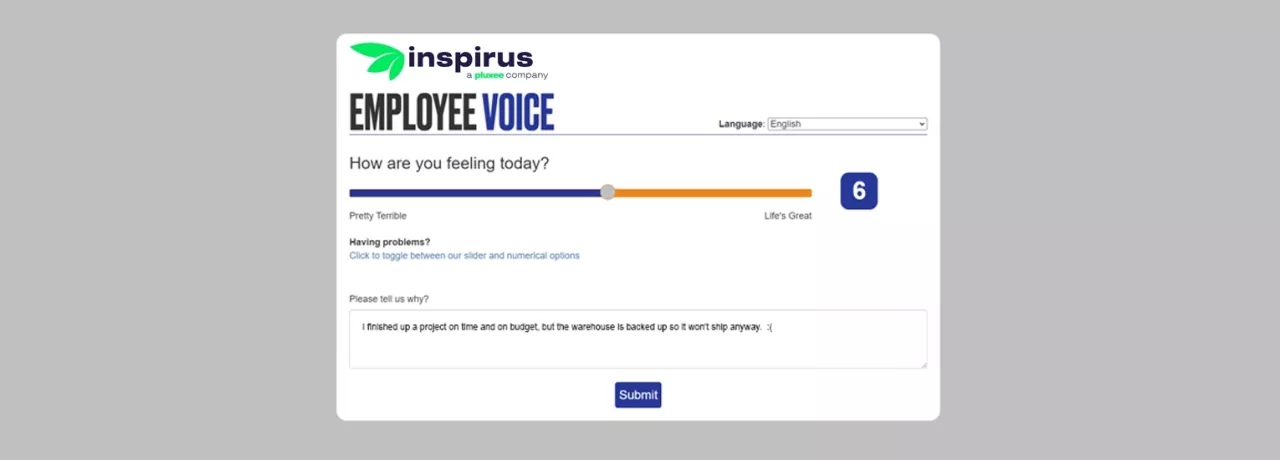What Employee Feedback Can Tell You

For many organizations — especially service organizations — employees are their primary resource. In any company environment, though, employees are a critical driver of organizational success. Their feedback is critical to improving the employee experience, company culture, and business operations.
Too often, employees don’t have a convenient or anonymous way to provide feedback. Giving them a platform where they can do that is a win-win: employees feel heard and valued for their perspectives, and organizations have real-time information they can use to increase employee engagement, enhance employee performance, and improve organizational culture.
This is critical at all levels of the organization, but especially on the front lines. Giving those employees a voice can pay off in many ways, especially in an environment where employee engagement levels are dropping.
Gallup tells us that employee engagement levels have been trending downward for the past few years — from 36% to 31% between 2020 and 2023.
Those numbers should be startling. Employee engagement directly impacts productivity, turnover, and — ultimately — a business’s profitability and success. Improving these numbers and turning around this trend should be a top priority for companies of all types and sizes.
Soliciting different types of employee feedback can be a great way to do just that, impacting a number of critical workplace issues.
Cultural Concerns
Forbes reports that employees want a workplace culture that is supportive, and inclusive and that uses encouragement and employee recognition to build community. Organizations that fail to provide this are at higher risk of employee turnover. Our employee engagement technology offers a Cultural Assessment Survey in conjunction with human insight partner The Happiness Index, which is accessed through the Connects platform. It gives employees the opportunity to provide anonymous positive or negative feedback about workplace culture and how it impacts them.
Employee Voice is a ‘pulse’ survey tool, integrated into Connects. This tool empowers team members to share their positive and negative feedback anonymously whenever they want, not just when they are asked. The survey asks two simple questions: "How are you feeling today?" and "Why," giving every employee the opportunity to be heard 24/7 – a true voice – no matter where they are located.
Results from both surveys provide organizations with real-time insights into how employees are thinking and feeling so they can adjust their people strategy and make actionable plans and performance reviews to improve engagement and productivity and create a thriving culture.
Value Alignment
Today’s employees, more than ever, expect their jobs to contribute to their personal sense of purpose. When that purpose is shared with their employer, it drives engagement.
During the pandemic, many employees took time to reexamine their purpose both in work and in life. The result of that assessment, for many, has driven what’s been called the “Great Resignation.” When employees don’t find purpose and meaning in their work, they’re likely to look for it somewhere else. But when employees feel their purpose and values are aligned with the organization’s they’re more productive — and loyal.
The Vision and Values Survey can give you a clear indication of how well-aligned employees are to your organization's vision and values — or the extent to which they’re not. This data can give you the insights and early warning signs you need to take steps to close any gaps.
Recognition Impact
Most organizations know quantitatively how their recognition program is working, but have been unable to qualitatively assess it, until now. The Recognition Impact Index is a specific rewards and recognition survey that can expose program awareness and participation, gauge the impact the program has on employee happiness and motivation levels, solicit feedback for program improvements, and gain visibility into benchmark data so that organizations can get a true picture of their recognition program and how it stacks up against other organizations. These learnings can drive program evolution, and fuel employee retention and top talent acquisition strategies.
Morale Levels
When organizations make an effort to solicit employee feedback — and make it easy and anonymous for employees to share their perspectives — it has a positive effect on morale. Employees who feel they are heard are much more likely to be happy and motivated to perform at their highest levels. That not only increases their job satisfaction, but it boosts overall morale, having a snowball effect on their peers.
Workplace Diversity Matters
Diversity, equity, and inclusion (DEI) are concepts that are top-of-mind for all organizations today. Organizations know that, more than ever, employees value diversity — and respect for diversity. In fact, 81% of candidates check a company’s website for their stance on DEI before applying.
Most workplaces today are, after all, comprised of employees representing a wide range of diversity — different cultures, races, and ethnicities. The interactions these employees have with each other have a significant impact on their sense of belonging, value, and engagement.
When these interactions lack respect, compassion, or understanding, problems inevitably arise. Gathering employee feedback, inclusively, provides an opportunity for every employee in the organization to share what’s important to them and empowers diverse groups to contribute equally. That drives inclusion, and belonging, and improves employee engagement.
Through Connects, employers can have access to two diversity surveys that can help them easily and seamlessly gather feedback from everyone in the organization yielding invaluable insights.
Differing Perspectives
Your employees represent a wide range of feelings and perspectives. Giving employees the opportunity to provide feedback allows those with different perspectives — unrelated to culture, race, or ethnicity — to have an equal voice.
Whether their perspectives are driven by different genders, age groups, experience levels, or simply unique ways different individuals approach situations and come up with innovative ideas, the opportunity to share perspectives, and have a voice, can be a key driver of engagement.
Feedback allows all employee voices and perspectives to be heard — and their contributions to be considered.
Common Stressors
A wide range of stressors impact today’s employees. From healthcare and personal well-being concerns that spiked during the pandemic to concerns about family responsibilities, personal finance and more, many employees have high levels of stress that contribute to their mental well-being.
Leaders need to uncover and understand the stressors that are impacting employees, and their common themes, so that they can be proactive in taking steps to alleviate the impacts of these stressors. For example, if results of employee feedback surveys indicate a rise in personal finance concerns, a virtual money management workshop might be in order.
Training Opportunities
The feedback you receive from employees can provide clues about the type of training opportunities that could address employee concerns and needs. When employee feedback consistently contains frustration about work-related problems (difficulty managing conflict, challenges with meeting deadlines on time, technology fatigue) or aspirations about other job opportunities (indications employees would be interested in learning more about AI, website development, management, and delegation, etc.), it could signal that training opportunities would be welcomed.
Operational Challenges
Employees have a firsthand perspective of what’s working — and what’s not — and often see things that their managers don’t. Their feedback can provide an opportunity to bring up areas of weakness in operational procedures, to make improvement suggestions, or to come up with completely new and innovative ideas.
Managerial Incompetence
Employees often may feel that they don’t have an outlet to share concerns about their supervisors or managers without fear of repercussions. Having access to an anonymous employee feedback tool like Employee Voice gives them the freedom — and sense of relief — needed to bring work environment issues forward, as they happen. And that’s exactly what you want them to do! When you start to see recurring mentions of one particular leader or manager that are consistently pointing to an issue, that’s a clear sign that something needs to be done.
Giving employees the space, the tools, and the sense of security needed to speak up about important topics, are vital employee engagement strategies that will make your workforce feel safe and supported. In doing so, you’ll create a culture of feedback that will lead to engagement, productivity, loyalty, and longevity.





